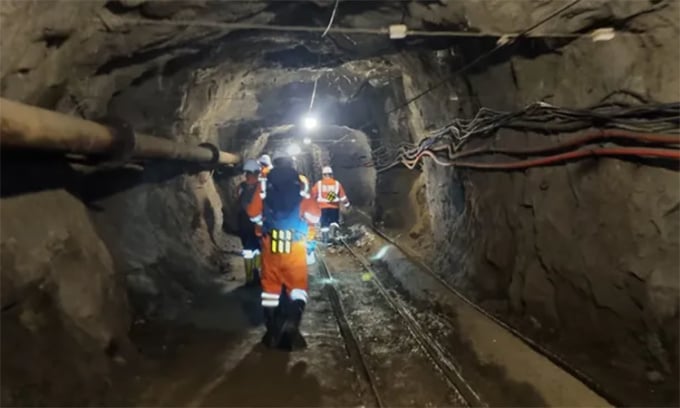Albania Scientists have discovered a huge underground hydrogen deposit with an escape rate of about 200 tons of hydrogen per year.

A team of scientists explores the Bulqize mine under the guidance of local miners. Photo: FV. Donzé
A new study published in the journal Science on February 8 suggests that a huge deposit of hydrogen may be hidden deep beneath the Bulqize chromium mine in Albania. The deposit is in a piece of the Earth’s crust and mantle that once lay at the bottom of the ocean and was stripped away when its tectonic plate slid beneath another. The piece was pushed onto land about 45 to 15 million years ago, forming a 3,000-kilometer-long belt of rocks called ophiolites that stretches from Turkey to Slovenia.
Ophiolites are found all over the world, and previous studies have documented hydrogen seeping from boreholes and deposits in these structures. In the new study, Laurent Truche, a geochemistry professor at the University of Grenoble Alpes, and his colleagues discovered the hydrogen deposits thanks to huge plumes of hydrogen emanating from lakes inside the Bulqize mine. Such hydrogen deposits could be exploited to provide carbon-neutral fuels, but the necessary infrastructure is lacking and the gas is notoriously difficult to extract.
Truche and his colleagues explored the deepest levels of the Bulqize chromite mine and recorded huge amounts of hydrogen seeping from the rocks and bubbling up from the lakes. Their measurements showed that at least 200 tons of high-quality hydrogen escape from the mine each year, one of the highest natural hydrogen flow rates ever recorded.
Hydrogen is a highly flammable gas. High concentrations of hydrogen in the Bulqize mine may have caused three explosions since 2011, killing four miners and injuring many others. “Our research will help understand this phenomenon and improve safety,” Truche said. The new study also sheds more light on the geological conditions that create large reserves of naturally occurring hydrogen underground.
Truche's team estimates that up to 50,000 tons of hydrogen could be hidden in the deposit, enough to sustain a high hydrogen flow rate for about 238 years. "What makes our new discovery unique is the large flow of nearly pure hydrogen that we observed. In the context of the energy transition, our discovery could have a significant impact on the search for new energy sources," they said.
Thu Thao (According to Live Science )
Source link


![[Photo] General Secretary To Lam receives King Philippe of Belgium](https://vstatic.vietnam.vn/vietnam/resource/IMAGE/2025/4/1/e5963137a0c9428dabb93bdb34b86d7c)
![[Photo] Close-up of Vietnam's sniffer dog team searching for earthquake victims in Myanmar](https://vstatic.vietnam.vn/vietnam/resource/IMAGE/2025/4/1/d4949a0510ba40af93a15359b5450df2)
![[Photo] President Luong Cuong and King Philippe of Belgium visit Thang Long Imperial Citadel](https://vstatic.vietnam.vn/vietnam/resource/IMAGE/2025/4/1/cb080a6652f84a1291edc3d2ee50f631)
![[Photo] Myanmar's capital in disarray after the great earthquake](https://vstatic.vietnam.vn/vietnam/resource/IMAGE/2025/4/1/7719e43b61ba40f3ac17f5c3c1f03720)
![[Photo] Prime Minister Pham Minh Chinh meets with King Philippe of Belgium](https://vstatic.vietnam.vn/vietnam/resource/IMAGE/2025/4/1/be2f9ad3b17843b9b8f8dee6f2d227e7)
































































































Comment (0)